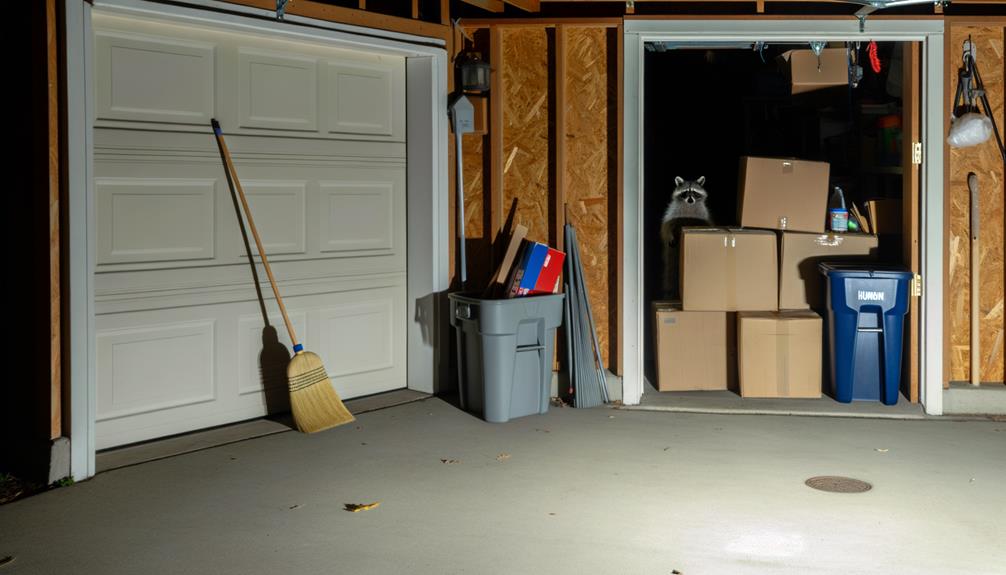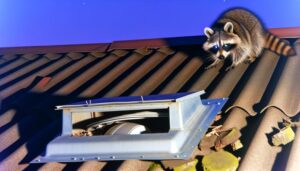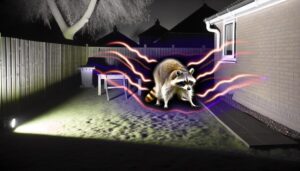How Do You Get a Raccoon Out of Your Garage in 5 Steps
To remove a raccoon from your garage, start by identifying signs such as overturned trash bins and nocturnal noises. Wear protective gloves, long sleeves, and safety goggles.
Inspect the garage thoroughly for entry points and block them to prevent re-entry. Humane trapping is recommended; use bait like marshmallows or canned tuna and place traps near entry points.
Regularly check traps to minimize raccoon stress and handle captured animals with care. Consult local regulations for humane relocation.
Effective removal involves understanding raccoon behavior and implementing preventive measures. For a detailed guide on managing raccoon intrusions, further information is available.

Key Takeaways
- Identify potential entry points and secure them to prevent further access.
- Remove all food sources to discourage the raccoon from staying.
- Use a high-powered flashlight to locate the raccoon's hiding spot.
- Set a humane trap with bait like marshmallows or peanut butter.
- Regularly check and promptly relocate the raccoon following local wildlife regulations.
Identifying Raccoon Presence
Identifying the presence of a raccoon in your garage involves recognizing specific signs such as overturned trash bins, scattered food, and distinctive paw prints. Raccoons leave behind characteristic five-toed prints and may also damage insulation or gnaw on wires. Fecal matter, which can carry pathogens, may be found near entry points.
Utilize a flashlight to inspect dark corners and crevices where raccoons might hide. Implement safety protocols by wearing gloves and a mask to avoid direct contact with potential contaminants. Additionally, listen for nocturnal noises such as scratching or thumping.
Documenting these signs accurately is pivotal for effective intervention, ensuring a humane and safe approach to removing the raccoon while maintaining the integrity of your environment.
Understanding Raccoon Behavior
Understanding the behaviors and habits of raccoons is essential to effectively addressing and mitigating their presence in your garage.
Raccoons are nocturnal creatures, primarily active during the night. They are highly intelligent and possess dexterous front paws, enabling them to manipulate objects and access food sources easily.
Raccoons are omnivorous, with diets ranging from fruits and insects to small mammals, which makes human waste and pet food particularly attractive. They are also known for their strong territorial instincts and may display aggressive behavior if they feel threatened.
Recognizing these behavioral traits allows for strategic planning in humane removal methods, ensuring both the safety of the raccoons and the residents. Employing an informed approach is vital for successful intervention.
Safety Precautions
Implementing thorough safety measures is crucial when attempting to remove a raccoon from your garage to prevent injury and secure a humane resolution. Begin by wearing personal protective equipment (PPE) such as gloves, long sleeves, and safety goggles to mitigate risks of scratches and bites.
Make sure the area is well-ventilated and devoid of flammable materials, as raccoons can become agitated and unpredictable. Utilize tools like a broom or an extendable pole to maintain a safe distance. Avoid direct contact, and never corner the animal, as this may provoke aggressive behavior.
Keep a clear exit route and avoid blocking potential escape paths. Finally, having a first-aid kit and contact information for local wildlife control professionals is prudent.
Inspecting the Garage
Thoroughly inspecting the garage is essential for effective raccoon removal.
Begin by checking for any potential entry points, such as gaps in doors, vents, or windows, to understand how the animal accessed the space.
Additionally, identify possible hiding spots, including cluttered areas, storage boxes, or dark corners, where the raccoon may be taking refuge.
Check for Entry Points
Inspecting your garage for potential entry points is vital in preventing raccoons from gaining access. Begin by examining the perimeter for any gaps, cracks, or openings. Pay particular attention to areas around doors, windows, and vents, as these are common ingress points.
Make sure that doors close securely and that weather stripping is intact. Seal any cracks or gaps using caulk or expanding foam. For larger openings, consider installing wire mesh or hardware cloth. Check that attic hatches or crawl space entrances are properly secured.
Regular maintenance and repairs are important in maintaining a raccoon-proof environment. Employing these proactive measures will greatly reduce the likelihood of raccoon intrusion, thereby guaranteeing the safety and cleanliness of your garage.
Identify Hiding Spots
After securing potential entry points, the next step is to thoroughly inspect the interior of the garage to identify any hiding spots where raccoons might be taking refuge. Pay close attention to cluttered areas, since raccoons favor dark, secluded spaces.
Utilize a high-powered flashlight to examine behind shelves, inside boxes, and under vehicles. Wear protective gloves and a mask to safeguard against potential zoonotic diseases. Listen for rustling noises or observe for droppings, indicative of recent activity.
Ensure that all food sources, including pet food or birdseed, are sealed and removed to discourage raccoon presence. By meticulously inspecting and clearing hiding spots, you will significantly improve the likelihood of safely evicting the raccoon from your garage.
Removing Food Sources
Eliminating accessible food sources is crucial for discouraging raccoons from frequenting your garage. Begin by securely storing pet food, bird seed, and human food in airtight, raccoon-proof containers.
Make sure that garbage cans have tight-fitting lids and are resistant to tampering. Regularly clean up any food remnants or spills, as even small amounts can attract raccoons.
Additionally, inspect the garage for hidden food sources such as boxes or bags that may contain edible items. Implementing these measures reduces the likelihood of raccoons being drawn to the area, thereby minimizing the risk of an infestation.
Using Light and Sound
Employing bright lights and noise-making devices can be effective strategies to encourage a raccoon to vacate your garage.
Utilizing motion-activated lights can disrupt the nocturnal habits of raccoons, making the environment less inviting.
Additionally, ultrasonic repellents or radios set to talk stations can create an auditory disturbance that further deters the animal from remaining in the space.
Bright Lights Deterrent
Utilizing high-intensity LED lights and ultrasonic sound devices can create an inhospitable environment for raccoons in your garage. Positioning LED lights strategically around entry points and dark corners guarantees consistent illumination, disrupting raccoons' nocturnal habits.
Select LED lights with motion sensors to conserve energy while maximizing deterrence. For ultrasonic sound devices, choose models emitting frequencies above 20 kHz, which are inaudible to humans but disturbing to raccoons.
Always follow manufacturer guidelines for installation and operation to ensure security and effectiveness. Regularly inspect and maintain these devices to prevent malfunctions.
Noise-Making Devices
How can noise-making gadgets, combining light and sound, be efficiently implemented to deter raccoons from inhabiting your garage?
Utilizing ultrasonic sound emitters that produce high-pitched noises undetectable to humans is a highly efficient approach. These gadgets can be paired with motion-triggered lights to startle and disorient raccoons, encouraging them to vacate the premises.
Position these gadgets strategically around potential entry points and high-activity areas within the garage. Adhere to manufacturer instructions for safe installation, maintaining the gadgets out of reach of children and pets.
Regularly inspect and maintain the gadgets to ensure peak functionality. By combining auditory and visual stimuli, you create an inhospitable environment for raccoons, promoting humane wildlife exclusion.
Setting Up a One-Way Door
To effectively guide the raccoon out of your garage without allowing re-entry, installing a one-way door is an essential strategy. This device permits the raccoon to exit but prevents its return, promoting humane eviction.
Begin by identifying the primary entry point the raccoon uses. Attach the one-way door securely over this opening, making sure it is flush with the surface to prevent gaps. Use heavy-duty materials to withstand potential tampering.
Monitor the door regularly to confirm the raccoon's departure. Safety protocols dictate wearing gloves and protective clothing to minimize disease transmission risks. Additionally, verify other exits are sealed to direct the raccoon through the one-way door.
This method balances efficiency with compassion, aiding in the raccoon's safe relocation.
Humane Trapping Methods
To guarantee the humane capture of a raccoon in your garage, selecting the appropriate live trap is vital.
Once the trap is chosen, baiting it effectively with raccoon-attracting food such as marshmallows or sardines will enhance your chances of success.
Proper placement of the trap in areas frequented by the raccoon, while following safety protocols to avoid harm to both the animal and humans, is necessary for a safe and humane capture.
Choosing Appropriate Traps
Selecting humane traps for raccoons requires understanding the various types of live-capture devices and adhering to safety protocols for both the animal and the homeowner. Tube traps and cage traps are commonly recommended, as they minimize stress and injury.
Confirm the trap is robust, with smooth edges to prevent harm. Position the trap in a well-ventilated area and check it frequently to avoid prolonged confinement, which can cause distress. Always wear gloves to prevent the transfer of scent and reduce the risk of zoonotic diseases.
Follow local wildlife regulations, and consider consulting a professional wildlife control expert for guidance. Safe and humane practices not only protect the raccoon but also warrant a responsible and ethical approach to wildlife management.
Setting Bait Effectively
Effective placement of bait is vital to guarantee the humane trapping of raccoons, as it directly influences the likelihood of a successful and stress-free capture. Selecting the right bait, such as marshmallows, canned tuna, or peanut butter, increases attractiveness due to raccoons' sharp sense of smell.
Place the bait securely at the rear of the trap to make sure the raccoon fully enters before triggering the mechanism. Always wear gloves to avoid transferring human scent, which can deter the animal. Regularly check the trap to minimize the raccoon's stress and assure a timely release.
Following these technical steps not only enhances trapping efficacy but also upholds humane standards, reflecting a commitment to ethical wildlife management.
Safe Trap Placement
Securing the humane trapping of raccoons requires strategic trap placement, prioritizing locations frequented by the animal for increased likelihood of capture. Position traps near entry points, food sources, or nesting areas within the garage.
Utilize durable, weather-resistant traps that comply with local wildlife regulations to guarantee ethical treatment. Secure the trap on a stable surface to prevent tipping or injury.
Check traps regularly, ideally every 12 hours, to minimize stress on the captured raccoon. Use gloves during handling to safeguard yourself and avoid transferring human scent, which may deter the raccoon.
Upon capture, promptly relocate the raccoon to a suitable habitat as specified by wildlife authorities. This guarantees both the animal's welfare and the safety of residential spaces.
Relocating the Raccoon
Relocating the raccoon requires a thorough understanding of local wildlife regulations and humane trapping techniques. Begin by consulting your area's wildlife control guidelines to ensure compliance.
Utilize live traps designed explicitly for raccoons, guaranteeing minimal stress and injury to the animal. Once trapped, handle the raccoon with heavy-duty gloves and transfer it to a secure, ventilated carrier.
Select a relocation site at least 10 miles away, preferably in a suitable habitat with ample food and shelter. Release the raccoon during daylight hours to reduce predation risks.
Always prioritize safety protocols to safeguard both the animal and yourself.
Preventing Future Intrusions
To prevent future intrusions, it is important to identify and seal any potential entry points in your garage with durable materials like steel mesh or metal flashing.
Inspect the garage door, windows, vents, and roof for gaps or vulnerabilities that could be exploited by raccoons.
Make sure that garbage and food sources are securely stored in raccoon-proof containers to minimize attraction.
Regularly maintain and monitor the structural integrity of your garage to anticipate any weaknesses.
Utilize motion-activated lights or ultrasonic repellents as deterrents.
Adhering to these safety protocols will not only safeguard your property but also protect the welfare of the animals by preventing hazardous encounters.
Your vigilance and proactive measures are essential in serving the broader community's safety.
Conclusion
Effectively removing a raccoon from a garage involves a blend of strategic planning and humane practices. Just as a locksmith employs precise tools to open a lock, addressing raccoon intrusion requires understanding their behavior, eliminating attractants, and employing safe trapping methods.
Implementing a one-way exit mechanism guarantees the animal exits without returning, while future prevention is safeguarded through meticulous inspection and sealing of entry points. Adherence to these protocols guarantees a raccoon-free and secure environment.






